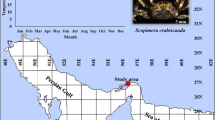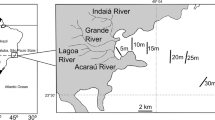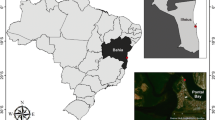Abstract
Scaly slipper lobster (Scyllarides squammosus) population ecology was examined using tag/recapture information at Necker Island (23°30′N; 164°35′W), Gardner Pinnacles (25°00′N; 168°50′W), Maro Reef (25°30′N; 170°45′W), and Laysan Island (25°48′N; 171°45′W) in the Northwestern Hawaiian Islands (NWHI) USA from 2002 to 2008. Although many aspects of S. squammosus life history and population dynamics were similar to those of other scyllarids, somatic growth differed from its congers. Scyllarides squammosus growth abruptly declined at maturity and, because of this, growth at length was better described using the Schnute as opposed to the more commonly von Bertalanffy growth model. Growth varied among locations, and survival varied among years; thereby being the first documentation of variability in the life history of a scyllarid. This study has expanded knowledge of scyllarid biology and documented that spatiotemporal variability in biological characteristics must be considered to understand and describe the population ecology of this species and probably of other scyllarids.





Similar content being viewed by others
Notes
Burton and Davie (2007) revised the previously monospecific genus Thenus therefore the T. indicus and T. orientalis information warrant caution.
References
Anderson DR (2008) Model based inference in the life sciences: a primer on evidence. Springer, New York
Bianchini ML, Ragonese S (2007) Growth of slipper lobsters of the genus Scyllarides. In: Lavalli KL, Spanier E (eds) The biology and fisheries of the slipper lobster. CRC, Boca Raton, pp 199–219
Bianchini ML, Bono G, Ragonese S (2001) Long-term recaptures and growth of slipper lobsters, Scyllarides latus, in the Strait of Sicily (Mediterranean Sea). Crustaceana 74:673–680
Botsford L, DiNardo G, Fogarty M, Goodman D, Hampton J (2002) Workshop proceedings on the development of spatially structured population models for Northwestern Hawaiian Islands lobster resources. NOAA Administration Report NMFS, SWFSC, H-02-01 Honolulu, Hawaii
Buckland ST, Burnham KP, Augustin NH (1997) Model selection: an integral part of inference. Biometrics 53:603–618
Burnham KP, Anderson DR (2002) Model selection and multimodel inference, a practical information-theoretic approach, 2nd edn. Springer, New York
Burton TE, Davie PJF (2007) A revision of the shovel-nosed lobsters of the genus Thenus (Crustacea: Decapoda: Scyllaridae), with descriptions of three new species. Zootaxa 1429:1–38
Carpenter KE, Niem VH (1998) FAO species identification guide for fishery purposes. The living marine resources of the Western Central Pacific, vol 2. Cephalopods, crustaceans, holothurians and sharks. Food and Agriculture Organization of the United Nations, Rome
DeMartini EE, Williams HA (2001) Fecundity and egg size of Scyllarides squammosus (Decapoda: Scyllaridae) at Maro Reef, Northwestern Hawaiian Islands. J Crustacean Biol 21:891–896
DeMartini EE, McCracken ML, Moffitt RB, Wetherall JA (2005) Relative pleopod length as an indicator of size at sexual maturity in slipper (Scyllarides squammosus) and spiny Hawaiian (Panulirus marginatus) lobsters. Fish Bull 103:23–33
Dulvy NK, Sadovy Y, Reynolds JD (2003) Extinction vulnerability in marine populations. Fish Fish 4:25–64
Edgar GJ (1990) Predator-prey interactions in seagrass beds. I. The influence of macrofaunal abundance and size-structure on the diet and growth of the western rock lobster Panulirus cygnus (George). J Exp Mar Biol Ecol 139:1–22
Fabens AJ (1965) Properties and fitting of the von Bertalanffy growth curve. Growth 29:265–289
Francis RICC (1988a) Maximum likelihood estimation of growth and growth variability from tagging data. N Z J Mar Fresh 22:42–51
Francis RICC (1988b) Are growth parameters estimated from tagging and age-length data comparable? Can J Fish Aquat Sci 45:936–942
Francis RICC (1995) An alternative mark-recapture analogue of Schnute’s growth model. Fish Res 23:95–111
Haddon M (2001) Modelling and quantitative methods in fisheries. Chapman & Hall/CRC, Boca Raton
Hardwick CW, Cline GB (1990) Reproductive status, sex ratios and morphometrics of the slipper lobster Scyllarides nodifer (Stimpson) (Decapoda: Scyllaridae) in the Northeastern Gulf of Mexico. Northeast Gulf Sci 11:131–136
Hearn A (2006) Life history of the slipper lobster Scyllarides astori Holthuis 1960, in the Galápagos Islands, Ecuador. J Exp Mar Biol Ecol 328:87–97
Hearn A, Toral-Granda V, Martinez C, Reck G (2007) The biology and fishery of the Galápagos slipper lobster. In: Lavalli KL, Spanier E (eds) The biology and fisheries of the slipper lobster. CRC Press, Boca Raton, pp 287–308
Holthuis LB (1991) FAO species catalogue, vol 13. Marine lobsters of the world. An annotated and illustrated catalogues of species of interest to fisheries known to date. FAO Fish Syn 13(125):1–292
Hutchings JA (2000) Collapse and recovery of marine fishes. Nature 406:882–885
Jones CM (2007) Biology and fishery of the Bay lobster, Thenus spp. In: Lavalli KL, Spanier E (eds) The biology and fisheries of the slipper lobster. CRC, Boca Raton, pp 325–358
Katsanevakis S (2006) Modelling fish growth: model selection, multi-model inference and model selection uncertainty. Fish Res 81:229–235
Lavalli KL, Spanier E (2007) Introduction to the biology and fisheries of slipper lobsters. In: Lavalli KL, Spanier E (eds) The biology and fisheries of the slipper lobster. CRC, Boca Raton, pp 1–21
Lebreton JD, Burnham KP, Clobert J, Anderson DR (1992) Modeling survival and testing biological hypotheses using marked animals: a unified approach with case studies. Ecol Monogr 62:67–118
MacDonald CD, Stimson JS (1980) Population biology of spiny lobsters in the lagoon at Kure Atoll—preliminary findings and progress to date. In: Grigg RW, Pfund RT (eds) Proceedings of the symposium on status of resource investigations in the Northwestern Hawaiian Islands. Miscellaneous Report UNIHI-SEAGRANT-MR-80-04. University of Hawaii Sea Grant College Program, Honolulu, Hawaii, pp 161–174
Mayfield S, Branch GM, Cockcroft AC (2000) Relationships among diet, growth rate, and food availability for the South African rock lobster Jasus lalandii (Decapoda, Palinurides). Crustaceana 73:815–834
McGarvey R, Ferguson GJ, Prescott JH (1999) Spatial variation in mean growth rates at size of southern rock lobster, Jasus edwardsii, in South Australian waters. Mar Freshw Res 50:333–342
O’Malley JM (2008) Evaluations of tag retention and a device for releasing discarded Hawaiian spiny lobsters Panulirus marginatus. N Am J Fish Manag 28:619–624
O’Malley JM (2009) Spatial and temporal variability in growth of Hawaiian spiny lobsters in the Northwestern Hawaiian Islands. Mar Coast Fish 1:325–342
Oliveira G, Freire AS, Bertuol PRK (2008) Reproductive biology of the slipper lobster Scyllarides deceptor (Decapoda: Scyllaridae) along the southern Brazilian coast. J Mar Biol Assoc UK 88:1–8
Pessani D, Mura M (2007) The biology of the Mediterranean Scyllarids. In: Lavalli KL, Spanier E (eds) The biology and fisheries of the slipper lobster. CRC, Boca Raton, pp 263–286
Phillips B (2005) Lobsters: the search for knowledge continues (and why we need to know!). N Z J Mar Fresh 39:231–241
Pollock DE (1991) Spiny lobster at Tristan da Cunha, South Atlantic: inter-island variations in growth and population structure. S Afr J Mar Sci 10:1–12
Polovina JJ (1989) Density dependence in spiny lobster, Panulirus marginatus, in the Northwestern Hawaiian Islands. Can J Fish Aquat Sci 46:660–665
Polovina JJ, R Moffitt (1989) Status of lobster stocks in the Northwestern Hawaiian Islands, 1988. NOAA Administration Report NMFS, SWFSC H-89-3, Honolulu, Hawaii
Relini G, Bertrand J, Zamboni A (1999) Synthesis of the knowledge on bottom fishery resources in central Mediterranean (Italy and Corsica). Biol Mar Medit 6(suppl):593–600
Sainsbury KJ (1980) Effect of individual variation on the von Bertalanffy growth equation. Can J Fish Aquat Sci 37:241–247
Schenker N, Gentleman JF (2001) On judging the significance of differences by examining overlap between confidence intervals. Am Stat 55:182–186
Schnute J (1981) A versatile growth model with statistically stable parameters. Can J Fish Aquat Sci 38:1128–1140
Schultz JK, O’Malley JM, Kehn EE, Polovina JJ, Parrish FA, Kosaki RK (2011) Tempering expectations of recovery for previously exploited populations in a fully protected marine reserve. J Mar Biol. Article ID 749131. doi:10.1155/2011/749131
Sharp WC, Hunt JH, Teehan WH (2007) Observations on the ecology of Scyllarides aequinoctialis, Scyllarides nodifer, and Parribacus antarcticus and a description of the Florida Scyllarid lobster fishery. In: Lavalli KL, Spanier E (eds) The biology and fisheries of the slipper lobster. CRC, Boca Raton, pp 231–242
Simpfendorfer CA (2000) Growth rates of juvenile dusky sharks, Carcharhinus obscurus (Lesueur, 1818), from southwestern Australia estimated from tag-recapture data. Fish Bull 98:811–822
Smith EB, Williams FM, Fisher CR (1997) Effects of intrapopulation variability on von Bertalanffy growth parameter estimates from equal mark-recapture intervals. Can J Fish Aquat Sci 54:2025–2032
Spanier E, Lavalli KL (1998) Natural history of Scyllarides latus (Crustacea: Decapoda): a review of the contemporary biological knowledge of the Mediterranean slipper lobster. J Nat Hist 32:1769–1786
Spanier E, Lavalli KL (2007) Slipper lobster fisheries–Present status and future perspectives. In: Lavalli KL, Spanier E (eds) The biology and fisheries of the slipper lobster. CRC, Boca Raton, pp 377–391
Stewart J (2003) Long-term recaptures of tagged Scyllarid lobsters (Ibacus peronii) from the east coast of Australia. Fish Res 63:261–264
Stewart J, Kennelly SJ (2000) Growth of the scyllarid lobsters Ibacus peronii and I. chacei. Mar Biol 136:921–930
Tuck ID, Chapman CJ, Atkinson RJA (1997) Population biology of the Norway lobster, Nephrops norvegicus (L.) in the Firth of Clyde, Scotland–I: growth and density. ICES J Mar Sci 54:125–135
Tyler JA, Rose KA (1994) Individual variability and spatial heterogeneity in fish population models. Rev Fish Biol Fish 4:91–123
Webber WR, Booth JD (2007) Taxonomy and evolution. In: Lavalli KL, Spanier E (eds) The biology and fisheries of the slipper lobster. CRC, Boca Raton, pp 25–52
Welsford DC, Lyle JM (2005) Estimates of growth and comparisons of growth rates determined from length- and age-based models for populations of purple wrasse (Notolabrus fucicola). Fish Bull 103:697–711
White GC, Burnham KP (1999) Program MARK: survival estimation from populations of marked animals. Bird Study 46(suppl):120–139
Acknowledgments
A special thanks to the scientists who participated in the tagging cruises and to the captain and crew of the F/V Marie M and F/V Katy Mary. I also thank C. Simpfendorfer for providing a copy of GROTAG; M. Donohue and J. Baker for statistical advice; and R. Toonen and G. DiNardo for their thoughtful insights. Helpful comments were provided in reviews by B. Bowen, R. Nichols, W. Walsh, and two anonymous reviewers. Financial support was provided by the National Oceanic and Atmospheric Administration Cooperative Research Program and National Science Foundation Grant OCE06-23678 to Rob Toonen. This is HIMB Contribution No. 1443 and SOEST Contribution No. 8137. Northwestern Hawaiian Islands activity was conducted under permit numbers NWHICRER-2006-003, PMNM-2007-023, and PMNM-2008-044.
Author information
Authors and Affiliations
Corresponding author
Additional information
Communicated by M. A. Peck.
Rights and permissions
About this article
Cite this article
O’Malley, J.M. Spatiotemporal variation in the population ecology of scaly slipper lobsters Scyllarides squammosus in the Northwestern Hawaiian Islands. Mar Biol 158, 1887–1901 (2011). https://doi.org/10.1007/s00227-011-1701-z
Received:
Accepted:
Published:
Issue Date:
DOI: https://doi.org/10.1007/s00227-011-1701-z




